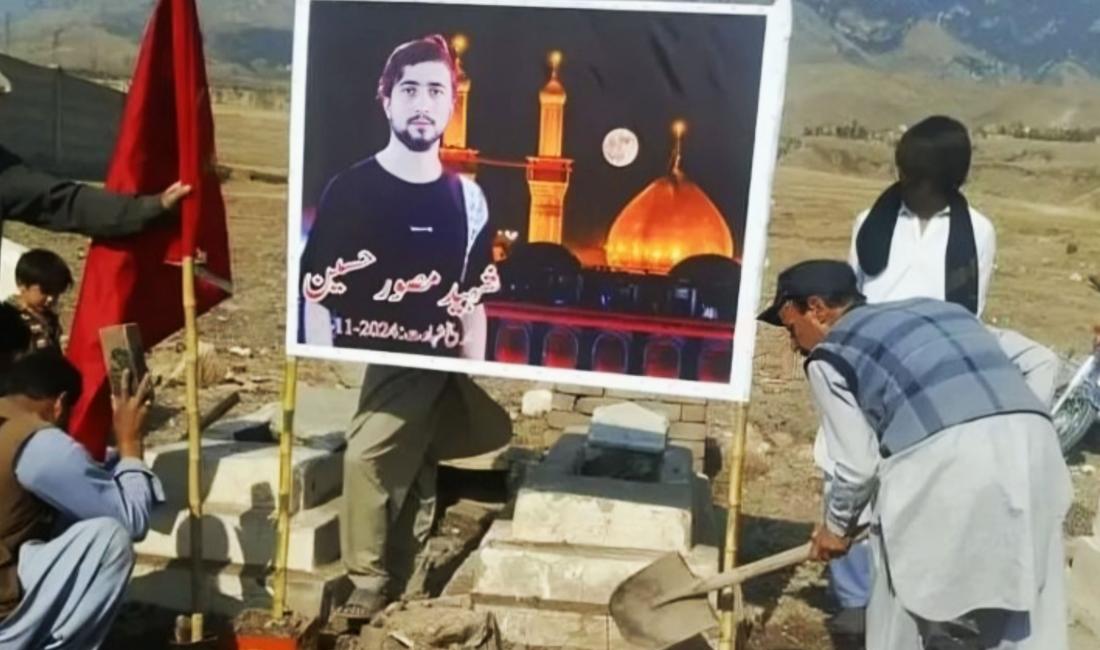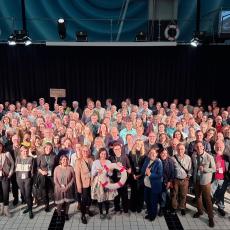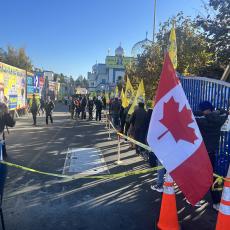A humanitarian crisis in northwest Pakistan reveals a government unwilling or unable to protect its people
This story was published and produced by Asia Democracy Chronicles. Photo: Pallbearers pour dirt into the grave of 19-year-old Shiite Musawir Hussain who was killed in a Nov. 21 attack ithat left at least 52, mostly Shiites, dead. Photo credit: Muhammad Nawaz, for Asia Democracy Chronicles)
Hadi Hussain had waited for over a month for the roads to reopen after yet another round of violent clashes in Pakistan’s border region had forced them shut.
The 19-year-old Shi’ite had prepared his passport and was set to travel from Kurram district in Khyber Pakhtunkhwa (KP) eastward to Islamabad, more than 330 kilometers away. There, he was to meet up with his father who was going to take him to a foreign mission to apply for a work visa.
Hadi never made it to the Pakistani capital. Last Nov. 21, militants ambushed a police-escorted convoy of dozens of vehicles as it passed through the Sunni-dominated Bagan Bazar. Hadi was among the 52 people killed.
“His only fault was that he was born to a Shi’ite household,” his father Daftar Hussain said. “In what era are we living? Even beasts treat children better than these terrorists who killed my son.”
But Asif Hussain, who lost his younger brother in the attack, said that the state was also to blame.
“They were under the protection of state security, and it was their duty to protect them,” he said. “But the state failed.”
Kurram is one of seven border districts in the former Federally Administered Tribal Areas (FATA), a semi-autonomous region in northwestern Pakistan. In 2018, FATA merged with Khyber Pakhtunkhwa (KP) province, integrating it into the country’s legal and administrative framework.
The area, however, is still operating under its own parallel legal system, governed by jirgas (tribal councils of elders). In these regions, weapons flow freely, and the border between Pakistan and Afghanistan remains porous.
In the last few years, there has been an uptick in violence in KP province, with daily attacks becoming increasingly frequent.
“In theory, FATA was merged into KP province in 2018,” Afrasiab Khattak, rights advocate and former senator from KP province, told Asia Democracy Chronicles (ADC). “But in practice, it seems as if KP is being merged into FATA.”
“Before,” he continued, “FATA was a no-go area and a black hole. But now the whole province has turned into a buffer zone where militants roam free, and the state lacks control.”
Divided land
In truth, the former tribal districts near the Afghan border have endured decades of unrest and remain a hub for various militant groups. A decades-old sectarian rivalry between Sunni and Shi’ite Muslims also continues to simmer in the region, and occasionally erupts into violence. This year alone has seen some 250 killed so far as a result of attacks and clashes between the two groups.
Over 96% of Pakistan’s over 241 million people are Muslim. While census data do not specify sectarian affiliations, an estimated 15 percent are Shi’ites, while the overwhelming majority follow Sunni Islam.
In Kurram, Shi’ites make up 42% of the population of about 800,000. The district is divided into three sections: the upper area, where Shi’ites are the majority, and the central and lower areas, dominated by Sunnis.
This division makes Shi’ites vulnerable when passing through Sunni villages, where attacks and clashes frequently occur.
Daftar Hussain, his voice trembling as tears streamed down his face, even asserted, “There is no one to raise a voice for us.”
Elsewhere in the country, Sunni and Shi’ite populations coexist peacefully, with only rare incidents of targeted killings involving religious figures from both communities. But in Kurram, the Sunni and Shi’ite communities are engaged in bitter land disputes in several villages, with other tribal conflicts often escalating into sectarian violence in the district.
Syed Irfan Ashraf, author and journalism assistant professor at the University of Peshawar pointed out, “While land disputes are common in many Pakistani cities, in Kurram, even these disputes take on a sectarian dimension.”
Known for its agricultural productivity, the region has valuable fertile land. Farmers also benefit from the Kurram River, which supports irrigation, while the region’s favorable climate allows for the cultivation of crops such as wheat, maize, and rice, as well as various fruits like apples, apricots, and plums.
The area’s fertile plains make it a significant contributor to local farming and horticulture – and to disputes that at times take a dangerous turn.
“The land disputes have also been a bone of contention,” Khattak said.
In July last year, 13 people were killed over a land dispute between both sects. But there was relative calm afterward until another land dispute triggered the latest round of violence.
Outside factors
Aside from local land disputes, Kurram’s sectarian conflict has been complicated all the more by major global events, including the Cold War, the Soviet invasion of Afghanistan, the Iranian Shi’ite Islamic Revolution, and the rise of the Taliban across the border.
During the Afghan War that began in the late 1970s, Kurram’s geographical proximity to Afghanistan had it playing a strategic role under the regime of Pakistan’s military dictator General Muhammad Zia-ul-Haq.
The region served as a vital logistical base for the jihadists fighting against Soviet forces, facilitating the flow of arms, training, and supplies to the former. Kurram also became a hub for Afghan refugees fleeing the Soviet invasion. Numerous refugee camps were established in the area, many of which became recruitment grounds for fighters.
The influx of fighters, along with their Sunni Islamist ideology, exacerbated sectarian tensions in Kurram. Khattak noted, “The region underwent demographic changes during the Afghan War, with an increase in the Sunni population, which the Shi’ite community viewed as a threat.”
Afghanistan would later come under the control of Sunni hardliners. By then, Pakistan’s southwestern neighbor, Iran, had long completed its own Shi’ite Islamic Revolution.
This led to an ideological battle between Sunni Saudi Arabia and Shi’ite Iran, further exacerbating tensions in the region. It also fueled local conflicts, creating divisions that continue to affect the region today.
In Pakistan, Kurram to this day is seen as a proxy battleground between Sunni and Shi’ite militants, with the Sunni faction led by Tehreek-e-Taliban Pakistan or TTP (also known as the “Pakistani Taliban”), which was formed in 2007, and the Shi’ite militant group, Zainabiyoun, recruiting fighters from Kurram’s main town, Parachinar.
“The conflict escalated into a more organized sectarian struggle with the emergence of the local Taliban in 2007,” Ashraf said.
“I spent my childhood surrounded by violence,” Asif Hussain told ADC. “And even now, at 30, there is no peace.”
Asif’s 19-year-old brother Musawir was accompanying their sister-in-law and young nephew to Islamabad in the convoy that came under attack last Nov. 21. The boy and his mother survived, but Musawir was among those killed.
“My 3-year-old nephew is carrying the same trauma that I have endured for the past 30 years,” said Asif.
Never-ending tit for tat
The cycle of violence has been endless because after one community attacks, the other retaliates swiftly. Two days after the Nov. 21 ambush, in which most of the fatalities were Shi’ite, it was the turn of Shi’ite militants to attack. They set fire to shops, homes, and state property in Bagan Bazar and Bacha Kot, resulting in several more casualties. Among the 33 confirmed dead, however, were 18 Shi’ites.
Sajjad Mubarak, a 35-year-old Sunni, had an electric store in the market. He said that he lost all of his shop’s inventory after the Bagan market was set on fire.
“They snatched the bread of my children,” he said. “I was not part of this conflict, but I became collateral damage. They took away the only source of income I had, and now I have nothing else.”
“I don’t support attacks on anyone, being Sunni or Shi’ite doesn’t make you a culprit,” he added. “Why don’t these terrorists understand that?”
Since the November attacks, the main road linking the Shi’ite-dominated upper Kurram with the rest of Khyber Pakhtunkhwa (KP) province has remained closed, and mobile phone signals are sporadically suspended.
The local population has expressed concerns about the shortage of basic supplies, including food and medicine. In the same month of the attacks, three children suffering from thalassemia died due to the lack of timely blood transfusions.
In early December, the provincial government tried but failed to send essential supplies by land; life-saving medications had to be airlifted in a helicopter. Several days later, Pakistan’s leading emergency response service, the Edhi Foundation, also delivered medicines to Parachinar via air ambulance.
The organization announced plans to operate additional air ambulance flights, subject to weather conditions and government approval, as harsh winter conditions have further added to the woes of locals.
“The government is not treating Kurram’s population as its citizens,” Akbar Khan, vice chairman of the Human Rights Commission of Pakistan (HRCP) told ADC. “Despite the conflict restarting in May, the government has failed to find a successful solution.”
He said that both the KP provincial government and Islamabad were more focused on political issues than on addressing the “humanitarian crisis” in Kurram.
Then again, a peace jirga formed in early December has the backing of the KP government, although it has yet to produce any results. Another jirga, this time sponsored by the Pashtun Tahafuz Movement (PTM) and has several representatives of Shi’ite and Sunni communities, along with those of KP’s main political parties participating, is also trying for a permanent truce.
This is not the first time such jirgas have been convened, however. Locals are also not very optimistic that either will lead to a lasting peace as there is lack of trust from both sides.
Jirgas, though, are far from the thoughts of Daftar Hussain, who was unable to attend the funeral of his son Hadi as the roads had been closed.
“I could not see the face of my son before he was buried,” he said. “It is a stain on my heart, a grief that I will carry with me. The state should be ashamed that a father was not able to pick up the coffin of his son.”



